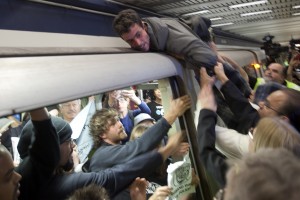While Los Angeles is struggling with flat rail transit ridership of late, the San Francisco Bay Area’s BART system is having a different problem: too many riders, particularly at peak times. And since the whole system funnels through a tunnel between Oakland and San Francisco, the problem has only become more intense in recent years.
On Monday at 7pm I’ll be guest hosting a radio program on KALW 91.7 FM in San Francisco to discuss the prospects of putting in a second rail tube under the bay to address the congestion. Guests will include BART director Rebecca Saltzman, Ratna Amin from SPUR, and architect Jeffrey Heller.
But while the region debates this long-term infrastructure solution, what can be done to address the problem in the meantime? It’s recently gotten worse due to strange power surges that are knocking train cars out of commission, as the San Francisco Chronicle reported today.
BART has announced a new incentive program to encourage riders to use the trains at off-peak hours. But for some strange reason, the agency has ruled out changing the fare structure to encourage this switch. As with Washington DC’s Metro, BART could charge more at peak times and less at off-peak times, in order to distribute the riders more evenly throughout the day and therefore give riders a more reliable, pleasant trip.
The downside? It could negatively impact low-income riders who have no choice but to commute during peak times. Or it could hurt overall ridership if too many people have to travel during peak times and would therefore seek other ways to commute.
But the upside could be a better functioning system that attracts more riders and keeps existing ones from bailing on crowded, unreliable trains.
All in all, I think it’s worth BART at least experimenting with variable fares. It’s a promising way to make use of a fixed resource and deal with the growing demand, particularly while we devise plans for long-term investments in the system.
About Ethan Elkind
Leave a Reply Cancel reply
You must be logged in to post a comment.



